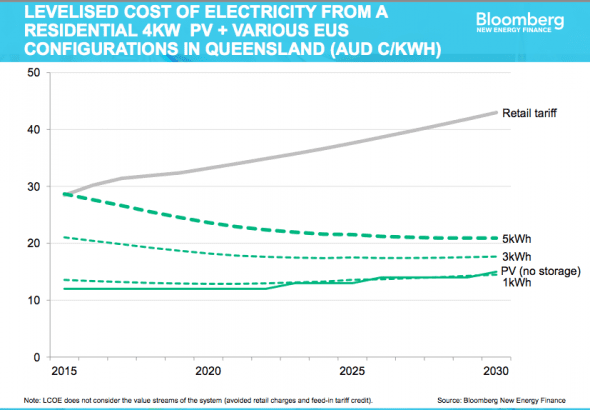 |
| Photovoltaic System, "Country-home" style (Wikipedia) |
Australian consumers can already install significant amounts of rooftop solar and battery storage at a cost that is cheaper than electricity from the grid, and the uptake of these two technologies is likely to be “unstoppable.”
This forecast came from Kobad Bhavnagri, the head of Bloomberg New Energy Finance in Australia, while outlining the reasons for the groups bullish forecasts, which predict 33GWh of battery storage and 37GW of solar PV in Australia by 2040.
“Solar and battery storage is simply unstoppable,” Bhavnagri said. He used this graph below to illustrate why.

Retail prices will continue to grow, but even if they remain flat, rooftop solar PV can already provide power to consumers in homes at well below the price of electricity.
Adding one kilowatt-hour of battery storage raises that cost slightly, but is still well below the cost of the grid-sourced power. Even 5kWh of battery storage can be installed and still costs are below that of the grid (these examples are taken in Queensland, with a 4kW rooftop solar system. A different version of this graph, showing the costs in payback terms, is included in this story on how battery storage prices are already falling in Australia).
“Storage technologies as well as PV will be able to provide costumers with electricity at a cheaper cost than the grid,” Bhavnagri says. “And as storage gets cheaper even larger amounts of storage will be able to supply consumers at a cheaper cost to the grid. On economic fundamentals this technology is unstoppable.”
Bhavnagri and many others, including Hazelwood coal generator owner Engie and a study by the CSIRO, believe that 50% of all electricity demand will be supplied “behind the meter” by 2040.
Not that Bhavnagri is urging consumers to quit the grid altogether. He says this would not be rational. “We will still need the grid for different purposes,” he said, including for back up capacity, support services, for the “Google operated” systems of appliances. “Grid and other companies have role in providing those services.”
But it will put huge pressure on networks to adapt their business models, and the way they operate the grid, and will almost inevitably result in a write-down of the grid’s value, which has been inflated by over-investment in recent years.
“The business model of the networks has to change. They have got to sell services instead of kilowatt-hours,” Bhavnagri said. “Much of what they built is redundant, resulting in excess capacity, and networks are overcharging and not delivering a commodity or service that is valuable to consumers.”
No comments:
Post a Comment